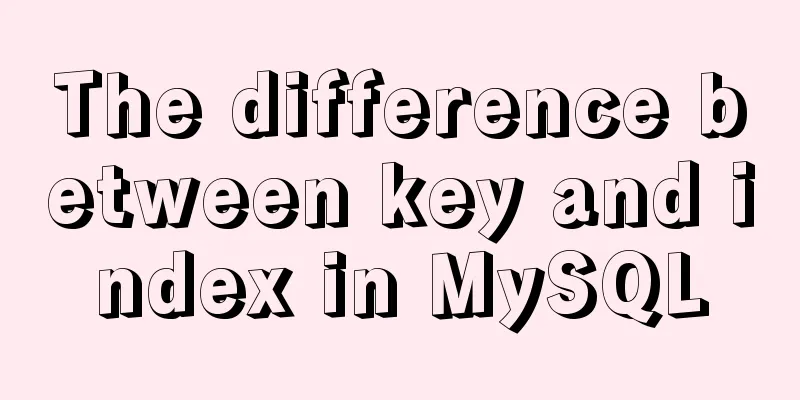The difference between key and index in MySQL

|
Let's look at the code first: ALTER TABLE reportblockdetail ADD KEY taskcode (taskcode) ALTER TABLE reportblockdetail DROP KEY taskcode Well, this is indeed where it gets confusing. We may not pay attention to this problem when using MySQL, because in most cases they show similar effects, but they still cannot be equated (at least in theory) The difference between an index and a key lies in their different starting points. The index is responsible for maintaining the search and operation speed of the table, while the key is responsible for maintaining the integrity of the table. If you have this confusion, it is probably due to a strange phenomenon in MySQL:
It's strange, right? They are two different things, but when they are created, they are attached to each other. Why do they do this? Because the reasons are:
Finally, let’s summarize:
In theory, MySQL key and index cannot be equated, they are not the same thing, but in actual use, there is basically no difference between them. Content extension: Difference between key and primary key CREATE TABLE wh_logrecord ( logrecord_id int(11) NOT NULL auto_increment, user_name varchar(100) default NULL, operation_time datetime default NULL, logrecord_operation varchar(100) default NULL, PRIMARY KEY (logrecord_id), KEY wh_logrecord_user_name (user_name) ) Difference between KEY and INDEX Note: I am still confused about this part. The difference between Index and Key in MySQL Key is the key value, which is part of the relational model theory. For example, there are primary keys and foreign keys, which are used for data integrity checks and uniqueness constraints. Index is at the implementation level. For example, you can create an index for any column in a table. Then, when the indexed column is in the Where condition in the SQL statement, you can quickly locate the data and retrieve it quickly. As for Unique Index, it is just a type of Index. The establishment of a Unique Index indicates that the data in this column cannot be repeated. I guess MySQL can make further special optimizations for Unique Index type indexes. Therefore, when designing a table, the Key only needs to be at the model level, and when query optimization is required, indexes can be created for the relevant columns. In addition, in MySQL, for a Primary Key column, MySQL has automatically created a Unique Index for it, so there is no need to create an index on it again. The above is the detailed content of the difference between key and index in MySQL. For more information about the difference between key and index in MySQL, please pay attention to other related articles on 123WORDPRESS.COM! You may also be interested in:
|
<<: How to use the realip module in Nginx basic learning
>>: How to install elasticsearch and kibana in docker
Recommend
CentOS7 uses rpm to install MySQL 5.7 tutorial diagram
1. Download 4 rpm packages mysql-community-client...
Windows Server 2016 Standard Key activation key serial number
I would like to share the Windows Server 2016 act...
MySQL common statements for viewing transactions and locks
Some common statements for viewing transactions a...
How to use vue-video-player to achieve live broadcast
Table of contents 1. Install vue-video-player 2. ...
Vue Element front-end application development conventional Element interface components
Table of contents 1. List interface and other mod...
MySQL dual-master (master-master) architecture configuration solution
In enterprises, database high availability has al...
Detailed tutorial on installing pxc cluster with docker
Table of contents Preface Preliminary preparation...
Several methods of calling js in a are sorted out and recommended for use
We often use click events in the a tag: 1. a href=...
WeChat Mini Programs Achieve Seamless Scrolling
This article example shares the specific code for...
An article to deal with Mysql date and time functions
Table of contents Preface 1. Get the current time...
A good way to improve your design skills
So-called talent (left brain and right brain) Tha...
Solution to MySQL Installer is running in Community mode
Today I found this prompt when I was running and ...
Front-end advanced teaching you to use javascript storage function
Table of contents Preface Background Implementati...
Detailed tutorial for upgrading zabbix monitoring 4.4 to 5.0
1. Zabbix backup [root@iZ2zeapnvuohe8p14289u6Z /]...
Two ways to create SSH server aliases in Linux
Preface If you frequently access many different r...









